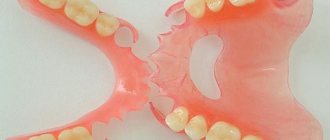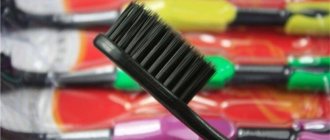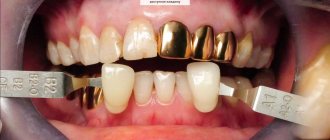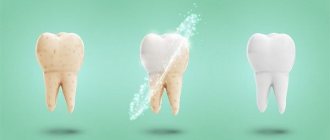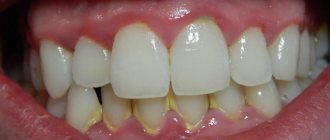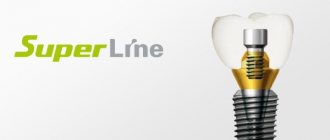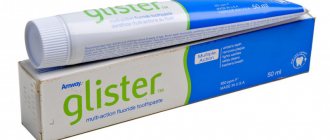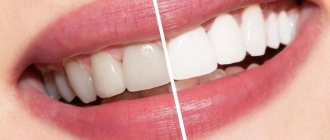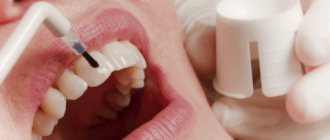Laser cleaning of plaque and tartar is an innovative procedure. Even in large cities, only a few clinics still use it, and its minimum cost is 2-3 times more expensive than standard types of professional hygiene: ultrasound and Air Flow.
Is it worth overpaying for laser cleaning, is it better than classical methods of removing deposits, what are its pros and cons and how the manipulation is carried out - we will look at this article.
Laser teeth cleaning, its advantages and disadvantages
Laser removal of pigmented and mineralized dental plaque is positioned as the best method of professional oral hygiene. They say it is completely safe and painless, and works more effectively than other methods.
But this is not entirely true. Despite the significant advantages, laser cleaning has its disadvantages and prohibitions, like any medical procedure.
The laser device is silent, which is important for patients with dental phobia
Among the advantages of manipulation are:
- removal of both supragingival and subgingival calculus;
- low pain – you shouldn’t count on a complete absence of pain, but laser teeth cleaning is more comfortable than other methods and does not require anesthesia;
- the ability to select the intensity of the mode - helps to adjust the desired power, taking into account the massiveness of the deposits, as well as the condition of the patient’s crowns and gums;
- silent operation – the device is silent, which is important for patients with dental phobia;
- non-contact conduction - the device itself does not touch the tissues, they are affected only by a laser beam;
- speed of execution - the procedure takes 30-60 minutes;
- safety – the laser does not affect the enamel in any way, which eliminates cracks and microdamages to the shell of the teeth;
- minimum gum bleeding - in advertising posts you can find the statement that the mucous membrane does not bleed at all, but in practice it is impossible to avoid damage to soft tissues;
- disinfecting and reparative effects - the laser beam destroys pathogenic flora, stimulates trophism and regeneration of soft tissues;
- whitening effect - units become 1-3 shades whiter due to the removal of plaque and stone, as well as polishing;
- Duration of effect – with proper care, teeth remain white for at least a year.
Before and after
But there are also disadvantages:
- minor discomfort during the procedure;
- possible bleeding gums;
- increased sensitivity of teeth after manipulation;
- a large number of contraindications;
- It is used in few places - even in large cities it is difficult to find a clinic where they perform laser cleaning;
- high cost - the price of laser treatment is at least 2-3 times higher than cleaning with ultrasonic scalers or an Air Flow device; only gum treatment with the Vector device comes close in cost.
Keep in mind that in 8% of patients the whitening effect is not achieved due to the yellowness of the enamel tissue: natural, as a result of taking tetracycline antibiotics or depulpation - removal of the nerve (statistical data provided by the information medical portal “DrZubastik” https://bit.ly/2E5ClbL) .
One more point is often overlooked. Laser treatment is always complemented by two procedures: cleaning massive deposits and polishing: manipulations are carried out manually or using an Air Flow installation. Before using the laser, the microbial film is removed with a sandblasting device, mineralized formations are partially removed and softened, and at the end of the procedure, the teeth must be ground, otherwise pigmented plaques will quickly attach to the rough surface again.
Such features have 2 negative points. Firstly, the advantage of the non-contact action of the laser is negated: the crowns are still treated mechanically and chemically. Secondly, the use of Air Flo is usually not included in the price list: this increases the already high cost of the procedure.
Before using the laser, remove the microbial film with a sandblasting device.
Without pain, stitches and antibiotics - you no longer have to be afraid of treatment!
Laser dentistry in the modern Interdent dental clinic in Moscow provides maximum patient comfort and a reduction in rehabilitation time after procedures. Using a laser, you can achieve positive therapy results even in the most difficult situations, and the absence of the need for anesthesia allows the device to be used for people with allergies to painkillers. Today, laser dental treatment in Moscow is widespread in dentistry, and enjoys deserved popularity among patients who appreciate the advantages of laser treatment. The use of laser at the Interdent family dental clinic is one of the safest and most effective treatment methods, which is indicated for almost everyone.
Indications and contraindications for use
Recommendations for laser dental plaque removal are standard. This:
- the presence of plaque and tartar;
- discoloration of enamel as a result of accumulation of pigment or mineralized deposits;
- addiction to smoking, excessive consumption of coffee and black tea - with such habits, plaque accumulates especially abundantly on the inside of the lower incisors;
- halitosis – bad breath;
- as a complex treatment of gingivitis, periodontitis, periodontal disease;
- retraction (drooping) of the gums due to the accumulation of supra- and subgingival stone;
- the need for careful hygiene in the presence of dentures, braces, implants;
- prevention of caries and gum inflammation.
There are many contraindications to laser teeth cleaning. Among them:
- pregnancy and breastfeeding;
- children's age - exposure to a laser beam can damage the “milk jugs” or disrupt the growth of molars;
- incomplete mineralization of enamel in adolescents - it will finally form at 16-18 years of age;
- inflammatory processes of the mucous membrane - first stop the acute phase, and only then carry out professional hygiene, otherwise the symptoms will intensify;
- installed endoprostheses, spinal structures: pacemakers, etc.;
- bronchial asthma;
- Chronical bronchitis;
- severe heart disease;
- serious infectious pathologies: tuberculosis, hepatitis, HIV, AIDS;
- acute respiratory and viral diseases - the procedure is postponed until complete recovery.
At the end of the procedure, the teeth must be polished
Relative contraindications are the presence of multiple large fillings, veneers, crowns, dental implants, braces. In such cases, some dentists perform manipulation, others claim that it can damage the structure.
In case of hyperesthesia (increased tooth sensitivity), laser cleaning can be performed. But under certain conditions: they give anesthesia and set the minimum gentle regime - it will not remove deposits so effectively, but the effect on units will be minimal.
When not to do laser cleaning?
A-Medic Clinic is a professional dentistry, so our specialists do not remove tartar if the patient has contraindications. To do this, before the procedure, an examination of the oral cavity is carried out, and if concomitant systemic diseases are suspected, a diagnosis is prescribed.
Laser cleaning is not recommended for patients who have contraindications:
- periodontitis or endocarditis;
- AIDS or hepatitis;
- asthma or tuberculosis.
Patients can receive a refusal from a specialist:
- under the age of 18;
- have a pacemaker;
- female during pregnancy or lactation;
- undergoing a period of treatment for malocclusion with braces (cleaning is done first);
- with installed implants or a large number of fillings;
- with sensitivity to ultrasound.
The procedure is also impossible during the development of ARVI, caries, sore throat or pharyngitis.
How is the procedure performed?
The principle of operation of laser oral hygiene is its effect on water. Dental deposits are porous, they contain a lot of liquid, but the enamel has almost none. The laser beam heats the water and evaporates it. As a result, the stones are destroyed, while the crowns remain intact.
Stages of laser cleaning:
- Examine the oral cavity and collect anamnesis. The hygienic index, the condition of teeth and gums, and the massiveness of deposits are determined. The patient is asked if there are diseases for which the procedure is contraindicated.
- Perform preliminary procedures. The patient is given an apron, hair cap and safety glasses.
- Remove bacterial film and large formations. Preliminary cleaning is carried out with an Air Flow device: it removes plaque by supplying a water-air mixture with abrasive particles under high pressure. If the stones are too massive, they are pre-etched with chemical compounds that soften and break down the hardened deposits.
- They carry out laser cleaning directly. The optical fiber is immersed in the periodontal junction and each tooth is treated for 30 seconds. During contact of the beam with adjacent tissues, evaporation of pathogenic microorganisms and dead areas of the mucous membrane occurs, with simultaneous splitting of stones. Deposits are removed from all sides of the crowns (vestibular, oral), from interdental spaces and hard-to-reach areas. Afterwards, the destroyed formations are washed off with water or blown off with a stream of air.
- Polishing is carried out. Roughness and unevenness are sanded off and the surface of the units is leveled. Manipulation is carried out manually (using polishing brushes, pastes and strips) or using a hardware method (using the Air Flow device).
- Fluoridation and remineralization are carried out. Crowns are coated with compounds containing fluoride, calcium, potassium, and phosphorus. This is necessary to strengthen the enamel and saturate it with useful elements.
The procedure takes 40-60 minutes.
Laser teeth cleaning does not last long. The standard procedure takes 40-60 minutes. If the deposits are massive, several visits will be needed.
Tip: Clean before installing fillings, veneers or crowns. After the procedure, the enamel brightens several tones. And since the color of old restorations is matched to the previous shade, they will look darker: those around you will notice the difference when you smile and in the photo.
Advantages of the method
With the help of electromagnetic waves, it is possible to achieve positive therapeutic results even in the most difficult situations, and the absence of the need for anesthesia allows the device to be used for people with allergies to painkillers. The use of laser in dentistry is one of the safest and most effective methods of treatment, which is indicated for almost everyone. However, there is still a small list of contraindications.
- Nervous system disorders
- Late stage diabetes mellitus
- Kidney failure
- Oncological diseases
- Pregnancy (1 - 6 months)
- Open tuberculosis
- Elevated thyroid hormone levels
- Allergy to sun rays
Dental care after the procedure
Any type of professional cleaning will be of no use if you do not adhere to the rules of hygiene.
Oral care after brushing your teeth is divided into 2 stages: in the first weeks and everyday.
Immediately after the procedure, adhere to the following tips:
- do not eat or drink for the first 2 hours;
- within 24 hours after laser treatment, do not clean your teeth - only rinse your mouth after eating and remove food debris with floss;
- to clean your teeth, buy a new brush: the old one contains bacteria and microbes that will cause inflammation in the disturbed gums;
- 2 weeks use a brush with soft bristles (marked Soft) and low-abrasive paste (RDA level up to 50 units);
- For several days, rinse your mouth with herbal decoctions of chamomile, sage, calendula: they will help eliminate bleeding, heal gums and reduce sensitivity;
- Follow a “white” diet for 2-3 weeks - all foods and drinks with coloring properties are excluded from the diet.
Daily care includes:
- giving up smoking, strong tea and coffee;
- careful adherence to oral hygiene: brushing teeth immediately after eating, using professional pastes, rinses, flosses, irrigators;
- preventive examination every six months;
- Carrying out hygienic cleaning every six months to a year.
Do not brush your teeth for 24 hours after laser treatment
LASER CLEANING IS THE BEST MODERN TECHNIQUE FOR THOSE WHO CARE ABOUT THE HEALTH OF THEIR TEETH
- We clean dental plaque in the same way as in premium dental centers in Europe, Israel and the USA.
- We use the same equipment and drugs produced by SIEMENS (Germany). This is a high-quality deep teeth cleaning that will satisfy the needs of the most demanding patients and will have a long-term beneficial effect on the oral cavity.
- We carry out a comprehensive procedure consisting of three cleaning stages: ULTRASOUND DEEP CLEANING, AIR FLOW CLEANING, ZIRCONIUM POLISHING.
- We strengthen teeth enamel after cleaning in 100% of cases.
- We do not use soda, which damages tooth enamel and gums!
Prices for laser teeth cleaning in Moscow, where can you undergo the procedure?
Even in the capital, finding a clinic where plaque and stone can be removed with a laser is a problem. There are very few such centers, and most dentists manage with classical methods of professional hygiene - with the help of ultrasonic scalers and Air Flo.
Tip: Laser whitening is often passed off as laser cleaning. These are different procedures, so check this point with the clinic manager.
The average price for laser teeth cleaning in Moscow varies from 10 to 20 thousand rubles. This is 2-5 times higher than professional hygiene using standard methods. You can undergo the procedure in the following medical centers in the capital:
| Clinic | Price |
| “Dr. Danielyan clinic” | 800 rub. for processing one tooth |
| "Good dentistry" | not listed on the center's website |
| "Capital" | RUB 25,400 for both jaws |
| "Dentum" | from 5,000 rub. |
| Elite Dental | from 800 rub. for one crown |
| "Dolmed" | from 450 rub. for removing deposits from one unit |
| "Premier" | from 1,070 rub. for removing plaque from one tooth |
Laser teeth cleaning in dental clinics in Moscow
- President prestige
- 6th street New Gardens, building 2, bldg. 1
- +7 (499) 938-… show all
- Mon, Tue 9:00–21:00; Wed 9:00–18:00; th-
3.6 ratings: 8
- Dentist
3.3 ratings: 4
- Dentistry Dmitrovich and colleagues
4.0 ratings: 4
- Dental fantasy
4.0 ratings: 4
- Vita+ troparevo
4.0 ratings: 4
- White rainbow
4.4 ratings: 5
- Dentist
4.4 ratings: 5
- Med-ostomy committee
3.9 ratings: 8
- kind hands
4.0 ratings: 3
- Kdk dent
4.8 ratings: 4
- Reiter
4.0 ratings: 4
- Implacity
4.6 ratings: 5
Further
Possible complications
There are usually no complications after laser removal of pigmented and mineralized deposits. Only standard consequences occur: minor bleeding and increased sensitivity, which disappear in a couple of days.
However, if the technique is not followed or contraindications are ignored, serious consequences arise: damage to teeth and gums, aggravation of existing oral diseases or systemic pathologies.
There are usually no complications after removing pigment and mineralized deposits with a laser
Equipment
Types of laser teeth whitening vary depending on the equipment used. The use of the revolutionary Doctor Smile system (Italy), based on the impact of diode lasers, allows you to:
- Ensure a uniform and gentle effect on tooth enamel, eliminating the risk of overheating and other possible complications.
- Even patients with highly sensitive teeth should visit her.
- Achieve maximum results by lightening the enamel by 6-8 tones or more in just one visit.
Patient reviews, before and after photos
Polina: “I carried out laser cleaning at the same time as caries treatment, since I had a lot of tartar. First, they lasered my teeth, then polished them and coated them with fluoride varnish. The procedure took half an hour. I want to warn you: if you have a low pain threshold, it will hurt. But overall it's tolerable. The crowns became whiter, the stone was completely removed, the enamel was not damaged. Now I undergo professional hygiene every six months, but I forgot about caries.”
Max: “I had laser cleaning done six months ago. Very unpleasant and painful. Afterwards, the teeth reacted not only to food, but to loud sounds and responded with pain. At least I was pleased with the effect: a snow-white smile from ear to ear. But, since I didn’t give up coffee or cigarettes, the crowns turned yellow again.”
Janusya: “I don’t have problems with my teeth, they’re just yellowed. But the gums are inflamed. During the cleaning, it was terribly uncomfortable and painful, and about 300 grams of blood poured out of the gums. But then everything healed, the bleeding and inflammation disappeared.”
The device cannot cope with deep subgingival deposits
Professional laser hygiene is presented as the best, absolutely painless and universal method. But that's not true. Discomfort during the procedure is still present, the device cannot cope with deep subgingival deposits, and the manipulation is expensive.
The only case when laser cleaning is really justified is severe inflammation of the gums. In this situation, the bactericidal and reparative effect helps to get rid of gingivitis or periodontitis many times faster.
In other situations, it is better to carry out standard hygienic cleaning with an ultrasonic scaler and an Air Flow device.
TEETH BECOME 170% STRONGER
Read more about the procedure for professional oral hygiene in this article.
Professional oral hygiene is a procedure that experts recommend to undergo once every 6 months.
UNIQUE PHOTOS SHOW THE RESULTS OF A STUDY OF HUMAN TOOTH ENAMEL AT THE UNIVERSITY OF TOKYO
HUMAN ENAMEL IN AN ELECTRON MICROSCOPE
CRACKS AND DESTRUCTIONS IN THE TOOTH ENAMEL ARE CLEARLY VISIBLE
PHOTO OF TOOTH ENAMEL AFTER A COMPLEX PROCEDURE USING THE LASER+ METHOD
IT IS VISIBLE THAT ALL THE CRACKS AND DESTRUCTIONS IN THE ENAMEL HAVE BEEN CLOSED—
THIS IS THE MOST CONVINCING EVIDENCE OF THE EFFECTIVENESS OF THE TECHNIQUE
DENTISTS WITH EUROPEAN QUALIFICATIONS CONFIRMED BY CERTIFICATES
Werner Elena Vladimirovna
Dentist periodontist
More details
Eremina Anna Arturovna
Dentist therapist
More details
Ozerov Petr Vladimirovich
Chief physician. Dentist, implantologist, orthopedist, surgeon. Laser dentistry specialist
More details
